1
Section One: The Fundamentals
A) What do we know about sport? What are common assumptions we make about sport and society?
| While it is true that for many people sports promote teamwork and unity, some may feel more isolated and excluded because of sport. For example, some people may have disabilities which prevent them from engaging in certain sports/ activities which alienates them from those who can participate. Youth sports may also serve as a platform to exclude those who do not have the means to participate, as some sports leagues have significant expenses such as equipment and travel. This results in exclusion of these youth from poorer households through no fault of their own. Lastly, sports can also serve to promote an individual’s ego rather than an opportunity to build the confidence of others. Many sports can be played individually, and even team sports often still have an individual which out-performs the rest, leading that individual to feel a sense of superiority over other team members.
Some of my peers also commented on toxicity and egotistical nature that sport can sometimes foster. I agree that for many people sports can create a sense of belonging and unity, some individuals are negatively impacted by the competitive nature of sports. |
Exercise 3: Notebook prompt
What are some other metanarratives about sport that you are familiar with? Find an image or video clip or draw something yourself that captures this idea…
So what? Why does any of this matter? Does it matter? As something we grow up with – live with – play through – we don’t often interrogate the meanings of sport, and perhaps we don’t want to.
But being aware of these assumptions and metanarratives is especially important, I would argue, because of the centrality of sport to our everyday lives, the role that sport plays in shaping our childhood and worldviews and….. [finish that thought]
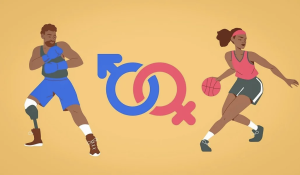
Kulkarni, Mansi. “Fair Play for All: Confronting Gender Biases in Sports.” Simply Sport, Simply Sport, 20 May 2024, www.simplysport.in/post/fair-play-for-all-confronting-gender-biases-in-sports. Sports are often seen as a platform to perpetuate gender inequality, but it does not have to be this way. I chose this image because I believe it represents the recent metanarrative that sports can be gender inclusive rather than a means to exclude women and more generally people who are not cis men. This metanarrative can be seen today through the establishment and promotion of women’s professional sports leagues like the WNBA and PWHL. I would argue that since sport helps to shape our childhood worldviews, sport can also be a concept which molds long-lasting impressions of gender roles and inclusivity.
|
B) What is social justice?
Exercise 4: Padlet Prompt
Think back to the last section and try to look at some of the ideas we discussed differently. How might sport and social justice actually co-exist?
Record any images, video clips, or gifs you added to the padlet and identify a point of intersection between sport and social justice (can be an issue or a barrier or a debate or something you would like to explore in more depth in this course) . Screenshot or paste in your response below.
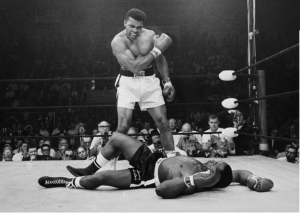
Heavyweight champion Muhammad Ali stands over fallen challenger Sonny Liston, shouting and gesturing shortly after dropping Liston with a short hard right to the jaw on May 25, 1965, in Lewiston, Maine. The bout lasted only one minute into the first round. Photo by John Rooney. Muhammad Ali was an American professional boxer who used his platform to advocate for social justice on a national and global scale. Ali was close friends with both Malcolm X and Martin Luther King Jr. and was also a strong advocate for civil rights during the black power movement in the 60s. Ali advocated for peace as well as racial equality, and he was openly against America’s involvement in the Vietnam war. By utilizing his fame generated through sport, Ali was able to create a significant discussion about global peace and equality in both sports and society as a whole. Reference: Joseph, Peniel. “Muhammad Ali Helped Make Black Power into a Global Political Brand.” UT News, University of Texas, 8 June 2016, news.utexas.edu/2016/06/08/muhammad-ali-helped-make-black-power-into-a-political-brand/.
|
C) Social Justice Reading
(note: this activity is optional!)
D) KINESIOLOGY AND SOCIAL JUSTICE
Exercise 5:
Exercise 6:
What are the implications of bodies-at-risk discourse and the refusal to understand the health gap from a social justice perspective, according to the authors of this article?
| According to the authors of this article, refusing to understand the health gap can be very dangerous to how healthcare is perpetuated in our society. The authors of this article assert that failure to understand health issues commonly associated with certain ethnic minorities can lead to intrinsic white supremacy, in that understanding the health issues common amongst caucasians can be considered more important to society. Furthermore, the authors state that ethnic minorities are often labelled irresponsible and/ or lazy for not taking care of their health as well as non-racial minorities, despite a greater emphasis being placed on how to treat and prevent health issues commonly faced by caucasians. The discourse around bodies-at-risk often fails to examine how segregation has impacted the way in which medical studies have been conducted, placing an unfair bias towards studying ailments of the majority, and thus often excluding individuals with disabilities, racial minorities and other demographics. The authors of this article urge health researchers to examine social justice and include more diversity amongst the groups which they survey.
|
Section Two: Sport Feminism
Exercise 7: Notebook Prompt
What is feminism? What does it mean to you? Choose one of the images below and explain how it captures your understanding of feminism (or find one that does speak to you and paste this into your pressbook with an explanation of why it matters to you.
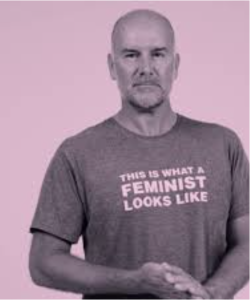
I chose this photo because I believe it challenges the common assumptions around who can be a feminist. Many people associate a feminism advocacy with women, but feminism is really about working to create a society in which all genders are granted equal rights and opportunities. This does not mean taking away rights and opportunities from other, which many men mistakenly believe.
|
Exercise 8: Notes Prompt (optional)
NB: Cornell notes is a great resource that teaches effective notetaking. Unfortunately, our system can’t save notes taken in the H5P app, so this is fully optional.
Exercise 9: Crossword Activity
Exercise 10: Padlet Prompt
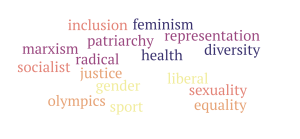
|
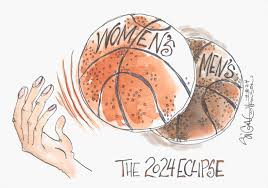
|
|

